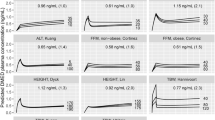Abstract
Forty three children ranged from 1 yr. to 6 yr. were randomly assigned to non-atropinized group (n=20; A(−) and atropinized group (0.015 mg·kg-1 i.m., n=23; A(+)). Control hemodynamics were measured under 0.5% halothane and 67% nitrous oxide and 33% oxygen for three minutes, and then halothane was increased to 2.5% and maintained for 15 min. In the A(−) group, stroke volume (SV) decreased to 64%, heart rate (HR) increased from 100/min to 111/min, and blood pressure (BP) decreased from 67 mmHg to 62 mmHg. Skin blood flow (SBF) concomitantly measured by a laser doppler flowmeter decreased to 48% and total peripheral resistance (TPR) increased to 128%. In the A(+) group, HR increased from ll7/min to 132/min (P<0.05, vs. A(−) group), BP decreased from 67 mmHg to 66 mmHg. SV decreased to 71% (P<0.05, vs. A(−) group). Changes in SBF and TPR were 68% and 128% respectively. End-expired halothane concentration in the A(+) group increased slower than in the A(−) group but not significantly. The results indicate increased sympathetic tone would work as a compensating mechanism for decreased SV and CO. Atropine premedication attenuated cardiovascular depression by maintaing HR and possibly by delaying induction speed of anesthesia. In conclusion, halotane-nitrous oxide anesthesia decreased SV without a marked decrease in heart rate and blood pressure in children. This decrease in SV and BP was attenuated by atropine premedication.
Similar content being viewed by others
References
Gregory GA, Eager EI II, Munosn ES: The relationship between age and halothane requirements in man. Anesthesiology 30:488–491, 1969
Nicodemus HF, Nassiri-Rahimi C, Bachman L, et al: Median effective doses (ED50) of halothane in adults and children. Anesthesiology 31:344–348, 1969
Cook DR, Brandom BW, Shiu G, et al: The inspired median effective dose, brain concentration at anesthesia, and cardiovascular index for halothane in young rats. Anesth Analg 60:182–185, 1981
Diaz JH, Lochhart CH: Is halothane really safe in infancy? Anesthesiology 51:A326, 1980
Miller BR, Friesen RH: Oral atropine premedication in infants attenuates cardiovascular depression during halothane anesthesia. Anesth Analg 67:180–185, 1988
Murray DJ, Forbes RB Dillman JB, et al: Haemodynamic effects of atropine during halothane or isoflurane anaesthesia in infants and small children. Can J Anesth 36:295–300, 1989
Berstein DP: Continuous noninvasive real-time monitoring of stroke volume and cardiac output by thoracic electrical bioimpedance. Crit Care Med 14:898–901, 1986
Introna RPS, Pruett JK, Crumrine RC: Use of trantrhoracic bioimpedance to determine cardiac output in pediatric patients. Cri Care Med 16:1101–1105, 1988
Wolf, WJ, Neal MB, Peterson MD: The hemodynamic and cardiovascular effects of isoflurane and halothane anesthesia in children. Anesthesiology 64:328–333, 1986
Barash PG, Glanz S, Katz JD, et al: Ventricular function in children during halothane anesthesia. Anesthesiology 49:79–85, 1978
Murry DM, Vandewalker G, Matherne P, et al: Pulsed doppler and twodimensional echocardiography: Comparison of halothane and isoflurane on cardiac function in infants and small children. Anesthesiology 67:211–217, 1987
Skovsted P, Price ML, Henry L, et al: The effects of halothane on arterial pressure, preganglionic sympathetic activity and barostatic reflexes. Anesthesiology 31:507–514, 1969
Fukunaga AF, Epstein RM: Sympathetic excitation during nitrous oxidehalothane anesthesia in the cat. Anesthesiology 39:23–36, 1973
Hill GE, English JE, lunn J, et al: Cardiovascular resoponses to nitrous oxide during light, moderate, and deep halothane anesthesia in man. Anesth Analg 57:84–94, 1978
Eisele Jr JH: Cardiovascular effects, Nitrous oxide. Edited by Eger II EI, London, Edward Arnold, 1985, 125–156
Seagard JL, Hopp FA, Donegan JH, et al: Halothane and the carotid sinus reflex. Anesthesiology 57:191–202, 1982
Wear R, Robinson S, Greagory GA: The effects of halothane on the baroresponse of adult and baby rabbits. Anesthesiology 56:188–191, 1982
Author information
Authors and Affiliations
About this article
Cite this article
Kawana, S., Namiki, A., Morita, Y. et al. Hemodynamic responses during induction of anesthesia with halothane-nitrous oxide in children with or without atropine premedication. J Anesth 6, 63–68 (1992). https://doi.org/10.1007/s0054020060063
Received:
Accepted:
Published:
Issue Date:
DOI: https://doi.org/10.1007/s0054020060063




